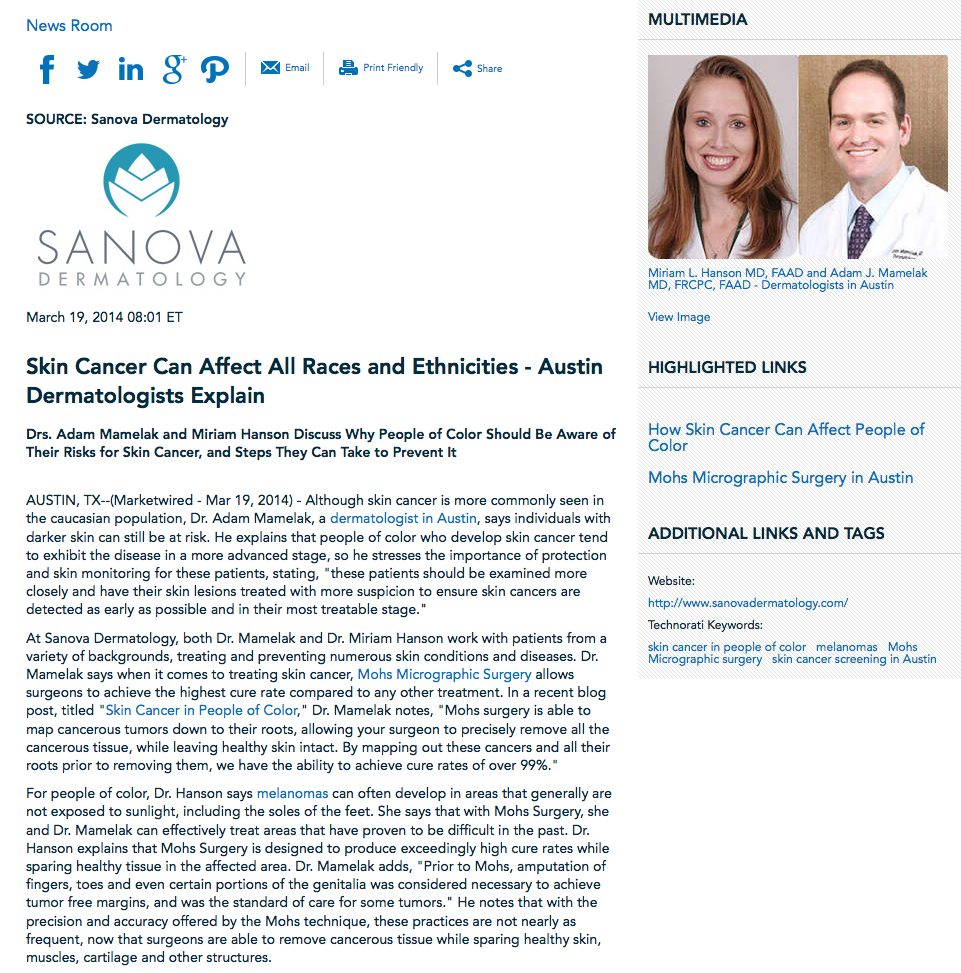
Drs. Adam Mamelak and Miriam Hanson discuss why people of color should be aware of their risks for skin cancer, and steps they can take to prevent it.
Austin, TX — Although skin cancer is more commonly seen in the caucasian population, Dr. Adam Mamelak, a dermatologist in Austin, says individuals with darker skin can still be at risk. He explains that people of color who develop skin cancer tend to exhibit the disease in a more advanced stage, so he stresses the importance of protection and skin monitoring for these patients, stating, “these patients should be examined more closely and have their skin lesions treated with more suspicion to ensure skin cancers are detected as early as possible and in their most treatable stage.”
At Sanova Dermatology, both Dr. Mamelak and Dr. Miriam Hanson work with patients from a variety of backgrounds, treating and preventing numerous skin conditions and diseases. Dr. Mamelak says when it comes to treating skin cancer, Mohs Micrographic Surgery allows surgeons to achieve the highest cure rate compared to any other treatment. In a recent blog post, titled “Skin Cancer in People of Color,” Dr. Mamelak notes, “Mohs surgery is able to map cancerous tumors down to their roots, allowing your surgeon to precisely remove all the cancerous tissue, while leaving healthy skin intact. By mapping out these cancers and all their roots prior to removing them, we have the ability to achieve cure rates of over 99%.”
For people of color, Dr. Hanson says melanomas can often develop in areas that generally are not exposed to sunlight, including the soles of the feet. She says that with Mohs Surgery, she and Dr. Mamelak can effectively treat areas that have proven to be difficult in the past. Dr. Hanson explains that Mohs Surgery is designed to produce exceedingly high cure rates while sparing healthy tissue in the affected area. Dr. Mamelak adds, “Prior to Mohs, amputation of fingers, toes and even certain portions of the genitalia was considered necessary to achieve tumor free margins, and was the standard of care for some tumors.” He notes that with the precision and accuracy offered by the Mohs technique, these practices are not nearly as frequent, now that surgeons are able to remove cancerous tissue while sparing healthy skin, muscles, cartilage and other structures.
Sun and excessive UV exposure is still considered the greatest risk factor for developing skin cancer, even in people of color. Drs. Mamelak and Hanson say the best course of action for skin cancer prevention is to wear a broad spectrum sunscreen with an SPF of at least 30, wearing sun protective clothing, seeking shade when outdoors, and avoiding the midday sun. They recommend for individuals of all races and ethnicities to watch for any suspicious moles or skin lesions that change color, shape, size, or texture, and to have a dermatologist or physician perform a skin check annually.
About Adam J. Mamelak MD, FRCPC, FAAD
Dr. Adam Mamelak is internationally known for his diagnosis and treatment of skin cancer. He founded the first Mohs Micrographic Surgery center in Ottawa, Ontario, and continues to work with the Mohs technique at Sanova Dermatology, his practice in Austin, Texas. Dr. Mamelak is board-certified in both Canada and the United States. He is available for interview upon request.
About Miriam L. Hanson MD, FAAD
Specializing in cosmetic dermatology, women’s health, and pediatric dermatology, board-certified dermatologist Dr. Miriam Hanson is a Diplomat of the American Board of Dermatology and a Fellow of the American Academy of Dermatology. Dr. Hanson is available for interview upon request.
To learn more about Sanova Dermatology, please visit sanovadermatology.com, twitter.com/DrAdamMamelak, or facebook.com/sanovadermatology.
Contact:
Sanova Dermatology
Plaza North Building
12319 North Mopac Expressway Ste. #100
Austin, TX 78758
(512) 837-DERM (3376)
Rosemont Media
tom@rosemontmedia.com
(858) 200-0044
www.rosemontmedia.com

